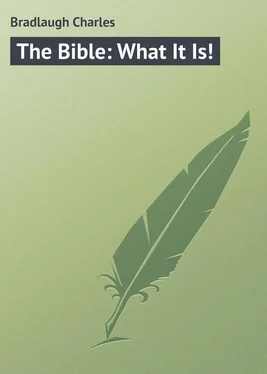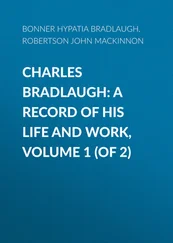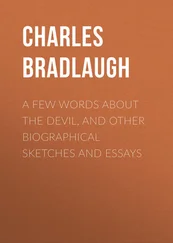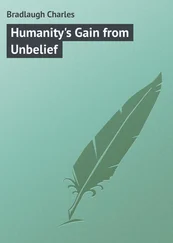Charles Bradlaugh - The Bible - What It Is!
Здесь есть возможность читать онлайн «Charles Bradlaugh - The Bible - What It Is!» — ознакомительный отрывок электронной книги совершенно бесплатно, а после прочтения отрывка купить полную версию. В некоторых случаях можно слушать аудио, скачать через торрент в формате fb2 и присутствует краткое содержание. Жанр: foreign_prose, на английском языке. Описание произведения, (предисловие) а так же отзывы посетителей доступны на портале библиотеки ЛибКат.
- Название:The Bible: What It Is!
- Автор:
- Жанр:
- Год:неизвестен
- ISBN:нет данных
- Рейтинг книги:5 / 5. Голосов: 1
-
Избранное:Добавить в избранное
- Отзывы:
-
Ваша оценка:
- 100
- 1
- 2
- 3
- 4
- 5
The Bible: What It Is!: краткое содержание, описание и аннотация
Предлагаем к чтению аннотацию, описание, краткое содержание или предисловие (зависит от того, что написал сам автор книги «The Bible: What It Is!»). Если вы не нашли необходимую информацию о книге — напишите в комментариях, мы постараемся отыскать её.
The Bible: What It Is! — читать онлайн ознакомительный отрывок
Ниже представлен текст книги, разбитый по страницам. Система сохранения места последней прочитанной страницы, позволяет с удобством читать онлайн бесплатно книгу «The Bible: What It Is!», без необходимости каждый раз заново искать на чём Вы остановились. Поставьте закладку, и сможете в любой момент перейти на страницу, на которой закончили чтение.
Интервал:
Закладка:
Bradlaugh Charles
The Bible: What It Is!
BOOK I. GENESIS
The Bible is the name by which the collection of Books beginning with Genesis and ending with Revelations is commonly known. It is derived from the Greek word [ – ] (Books), and this name is supposed to have been first applied in the fifth century by Chrysostom, before which time those books were known as [ – ] holy writings, sacred writings, writings of God.
The Bible is divided into three parts: the Old Testament, containing thirty-nine books, the New Testament, containing twenty-seven books, and the Apocrypha, containing fourteen books; making in the whole eighty books. It is only the first portion, known as the Old Testament, upon which I intend to treat at present. It professes to be translated from the Hebrew, in which Language (according to the learned Parkhurst) God communicated with Adam; or, perhaps to quote the learned divine more correctly, I ought to say that 'Hebrew was the language in which God taught Adam to speak.' It has been suggested by other saintly writers that Hebrew will be the language spoken in Paradise by the Saints. It is perhaps to be regretted that God did not choose a language more copious, and less capable of being misconstrued; but I will not at present stop to question whether the fact be as above stated – it is sufficient for us to know that the original of the Old Testament is (with some slight exception) written in the Hebrew.
The Old Testament is divided by the Jews into three parts, called 1st, (the law) – this division includes Genesis, Exodus, Leviticus, Numbers, and Deuteronomy; 2nd, (the Prophecies) – this portion contains the Books of Joshua, Judges, Samuel, and Kings, which are known as the former prophets, and Isaiah, Jeremiah, Ezekiel, Hosea, Joel, Amos, Obadiah, Jonah, Micah, Nahum, Habakkuk, Zephaniah, Haggai, Zachariah, and Malachi – of these, the three first are called 'the greater Prophets,' and the remaining twelve 'the lesser'; 3rd, (holy writings), comprising the Psalms, Proverbs, Job, Song of Songs, Ruth, Lamentations, Ecclesiastes, Esther, Daniel, Ezra, Nehemian, and first and second Chronicles. I have given the books in their Jewish order, which differs from our own, Chronicles being the last book of the Hebrew Bible.
The earliest complete translation into English of the whole of the Bible was made in the fourteenth century by the famous John Wickliffe, who was born in 1324 and died in 1384. This translation was reprinted in 1731, and again in 1810. Wickliffe's version of the Old Testament, I believe, still remains in manuscript. Portions of the Bible had been previously translated into Saxon, and it is alleged that one John de Trevisa had completed a translation prior to Wickliffe.
The next translation appears to have been made by William Tyndale (a native of Gloucestershire, born about 1477, and cruelly murdered in September, 1536) who, in 1526, printed two editions of the New Testament, which were issued from Wittemberg; both of these were, however, bought up by the Church authorities, and committed to the flames. Tyndale, however, nothing daunted by this, continued his work of translation, in which he is said to have been assisted by Martin Luther; Tyndale at this time residing at Antwerp, to which place he had been compelled to fly in 1523, to avoid the persecution of the priests.
It is worthy of notice that the Bible, which is alleged by the priests to be God's word revealed to the people, was never revealed to the people of England in their own tongue until the fourteenth century; that it was not until fifty-two years after printing had been introduced into England that any attempt was made to print an English edition: and that the first man who was sufficiently religiously disposed to print an edition, had his work burnt by the very men who, if their doctrines are true, should have zealously guarded each copy. Not only were the Bibles burnt, but every person in whose possession they were found was subjected to severe punishment. Despite all this, the editions issued by Tyndale were eagerly bought; and efforts were then made by King Henry VIII., Cardinal Wolsey, and Sir Thomas More, to lure poor Tyndale back to England, but he was too cautious to return. His friend, John Frith, who had assisted him in translating, was more credulous; and, returning to London upon the king's promise of safety, was arrested and burnt. Tyndale was ultimately entrapped, and strangled and burnt at Vilvoord, near Antwerp.
One would now be inclined to think that the priests well knew that to place the Bible in the hands of the people would be to tear down the veil from the temple, would expose their trickeries, and would place in the hands of the mass the means of detecting their false pretence. Under the guise of preachers of a revelation from God, they had ruled the minds of the people; and they were fully aware or the danger which would accrue to themselves should the people ever examine too closely into the merits of that revelation. Sir Thomas More wrote against Tyndale in language which will startle the readers of the present day, especially when we remember that Tyndale's crime was the presenting us with a translation of the Bible admirable for its style and general accuracy. More says, 'Our Saviour will say to Tyndale, Thou art accursed, Tyndale, the son of the Devil, for neither flesh nor blood hath taught thee these heresies, but thine own Father, the devil, that is in Hell. Ah, blasphemous beast, to whose roaring and lowing no good Christian man can, without heaviness of heart, give ear.' The next published translation was by Miles Coverdale (born 1535), who partially used Tyndale's text. Coverdale appears only to have translated from the Dutch and Latin into English. It does not seem at all clear that Tyndale translated from the Greek and Hebrew direct. It is quite certain that prior to this time the monks placed great difficulties in the way of acquiring either of those languages, in fact, Erasmus tells us that to know Greek was to be suspected, and to know Hebrew would prove you heretic outright.
The next is known as Matthewe's Bible, which is supposed to have been issued in the early part of the sixteenth century, by Richard Grafton. It is merely a collation of the texts of Tyndale and Coverdale.
About the same time were issued Cranmer's and Taverner's editions of the Bible.
The Geneva edition, issued in 1560, is that which is commonly known as the 'Breeches Bible,' on account of the translation of Genesis, c. 3, v. 7. I have a copy of this in reference.
Bishop Parker's Bible was issued in 1568. This edition was completed by the aid of several learned men, and differs considerably from its predecessors.
In 1582, the Douay edition of the New Testament was issued; and, in 1609, the Old Testament also. The former was printed at Rheims, the latter at Douay; and both were issued under the superintendence of Cardinal Allen. This brings us to the period at which what is commonly known as the authorised version was issued. This being the version I have to examine, I shall quote the history of it as given in an able article which appeared in the Penny Cyclopædia : – 'Early in the reign of King James I., there was a conference of divines of different opinions, at Hampton Court, for the settling of the peace of the Church. In this conference much was said concerning the imperfection of the existing translations of the Scriptures. The king himself, who was often present at these meetings, expressed a strong opinion on that point of the debate. "I wish," said he, "some special pains were taken for an uniform translation, which should be done by the best learned in both Universities, then reviewed by the bishops, presented to the Privy Council, and, lastly, ratified by royal authority, to be read in the whole Church, and no other." Out of this speech of the king's arose the present English Bible; for the suggestion soon ripened into a resolution. As this is the Bible which has for more than two centuries been the only Bible allowed to be read in the English Church, and as it is also the Bible universally used in dissenting communities, we may be expected to give a more extended notice of it than of the former editions. Fifty-four of the persons in that age most distinguished for that particular species of learning which such a duty required, were selected for the work, according to the king's suggestion; finally, forty-seven of them undertook it. They divided themselves into six independent classes, to each of which a certain portion of the work was assigned. Each person in the class was to produce his own translation of the whole committed to them, and these several translations were to be revised at a general meeting of the class. When the class had agreed upon their version, it was to be transmitted to each of the other classes; so that no part was to come out without the sanction of the whole body.
Читать дальшеИнтервал:
Закладка:
Похожие книги на «The Bible: What It Is!»
Представляем Вашему вниманию похожие книги на «The Bible: What It Is!» списком для выбора. Мы отобрали схожую по названию и смыслу литературу в надежде предоставить читателям больше вариантов отыскать новые, интересные, ещё непрочитанные произведения.
Обсуждение, отзывы о книге «The Bible: What It Is!» и просто собственные мнения читателей. Оставьте ваши комментарии, напишите, что Вы думаете о произведении, его смысле или главных героях. Укажите что конкретно понравилось, а что нет, и почему Вы так считаете.












